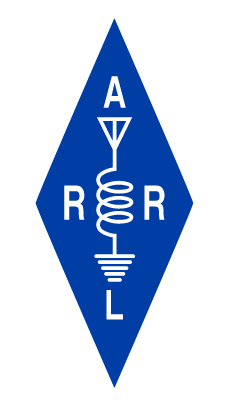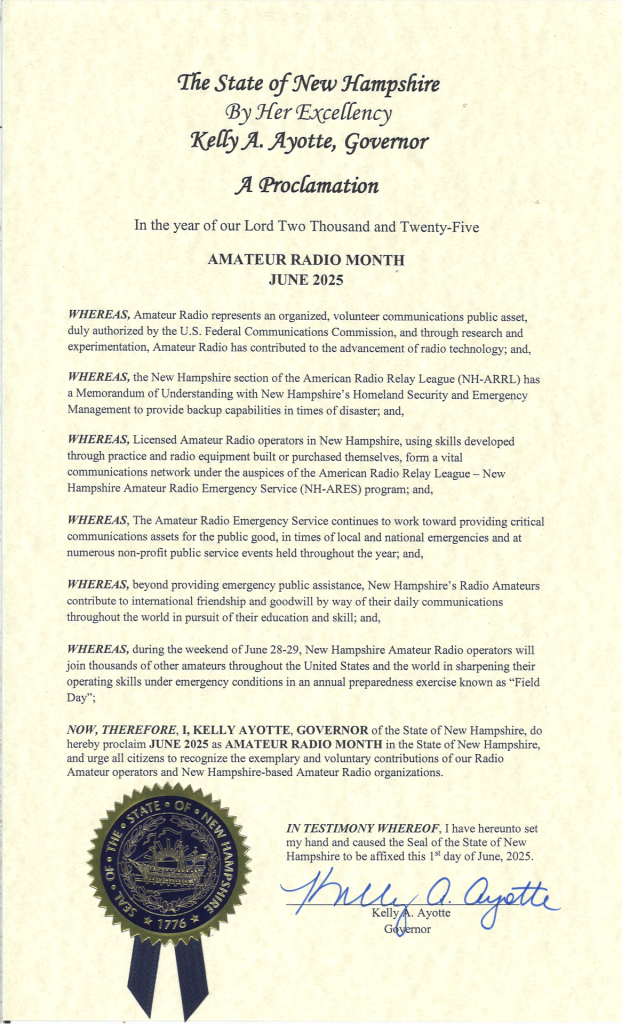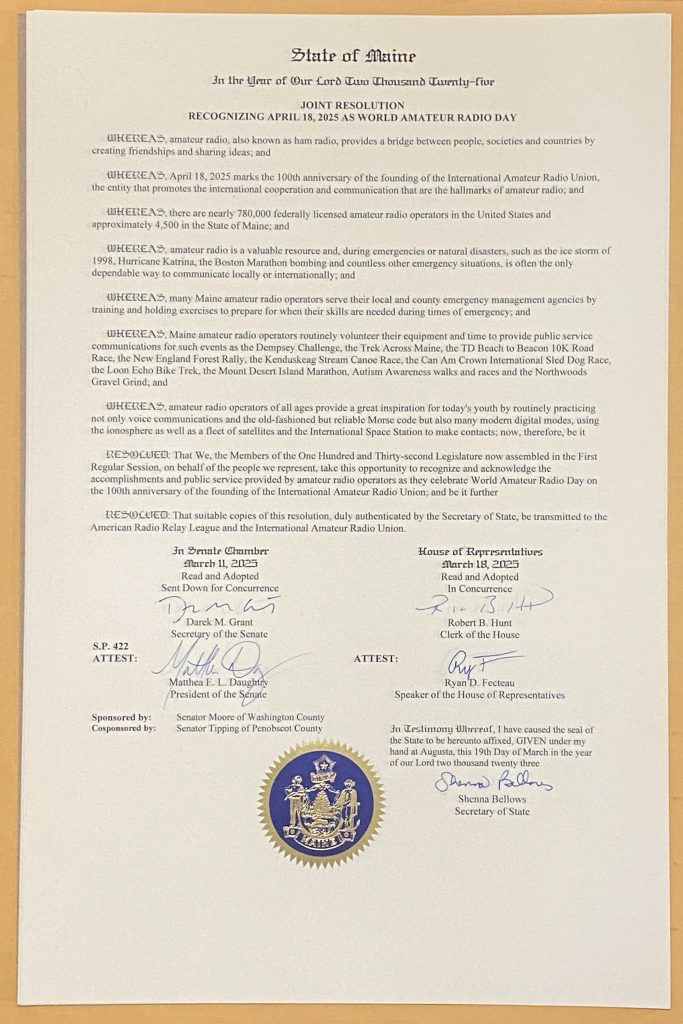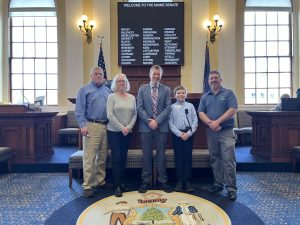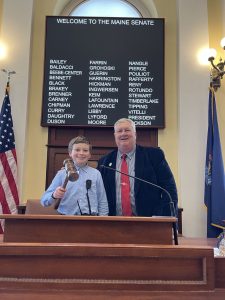Regulatory & Advocacy
Maine Section Effort Produces State Legislature Joint Resolution Recognizing Amateur Radio
The Maine State Legislature recently passed a joint resolution recognizing ham radio operators and the 100th anniversary of the IARU, according to Maine ARRL Section Manager Phil Duggan, N1EP.
“Thank you to Maine State Senator Marianne Moore for sponsoring the resolution and Senator Mike Tipping, N1YIQ, for co-sponsoring.”
NextNav, Inc. 902 MHz Proposal and its Potential Impact on Meshtastic
On Mon, Sep 16, 2024 at 5:08 PM Ez via groups.io <Ez.W1AEZ=gmail.com@groups.io> wrote:
Only 4 days left! It is vital (and free) to take action before September 20th, 2024
What is going on? The Federal Communications Commission (FCC) is currently allowing public comment on a proposal by NextNav Inc. that would reconfigure the 902-928 MHz band used by amateur radio and Meshtastic, and replace it with a backup GPS system.
At the very least, this is likely to disrupt range and performance of Meshtastic devices- but the implications could be far wider.
Take action before September 20th, 2024
The fastest way to take action is to submit an Express Comment at the FCC website. Here is a direct link with docket number pre-filled. Or click here to learn more.
Your action is vital to keeping the 900 Mhz network open to all!
Crichton at Meshtastic has a detailed writeup at the Meshtastic blog, as well as a published opposition letter from Meshtastic President JM Casler. We encourage all to read Crichton’s post to get a full understanding of the FCC proposal and the negative effects it would have on the Meshtastic community.
Only 4 days left to take action, then the FCC will make a decision
The fastest way to take action is to submit an Express Comment at the FCC website. Here is a direct link with docket number pre-filled. Or click here to learn more.
902 MHz Threatened
Matt Penttila, NA1Q , writes:
If you are not aware there is a docket coming to the FCC, 24-240. This docket is not good for the current users on 902-92 MHz, which amateur radio operators have a secondary status. Not a lot of hams are on 902-928 MHz, but it is a very usable band, using repurposed commercial equipment from GE, Motorola, Uniden, Maxon, EF Johnson, and amateur equipment by Kenwood, Alinco and Retevis. Currently just in New England there are 16 linked repeaters for the NEAR900 network, and numerous others throughout New England and hundreds if not over a thousand of other 900 MHz repeaters across the US. Most are put up by clubs or individual amateurs, at thrir expense for the use by all amateur radio operators.
Unfortunately the window is rather short for comments right now, but if it does go into effect, comments are to be filed by September 5th 2024 and replies to comments filed by September 20th 2024.
More info on the effect of this is on the website:
https://www.n1wbv.net/response-to-the-nextnav-fcc-petition.html
Also attached is a PDF comment letter from David Tucker, N5ZDT, to the FCC about this docket.
Remember a similar thing happened in back in 1988 and we lost 220-222 MHz. Even if you are not active or do not use the band, please write a comment, even if it is to click and paste parts from these sources. Let’s not lose this band to one commercial interest.
Thank you, 73,
Matt Penttila, NA1Q
Past President Blackstone Valley Amateur Radio Club
Past President Quaboag Valley Amateur Radio Club
Past Member CMARA
Past Member Mohawk ARC
Past Member MTARA
Past Member ECARA
Lifetime member ECARS 10201
ARRL Member
ARRL Urges Protecting the Amateur Radio 902-928 MHz Band
From ARRL News:
08/15/2024—The Federal Communications Commission (FCC) accepted for public comment a Petition for Rulemaking filed by NextNav Inc., a licensee in the 900-MHz Location and Monitoring Service (LMS), to completely reconfigure the 902-928 MHz band and replace the LMS with high-powered 5G cellular and related location services.
The FCC Notice requested comment on the effects that NextNav’s proposals would have on amateur radio operations in the band. ARRL® The National Association for Amateur Radio® is preparing comments urging protection of existing and future amateur uses in this band and urges all amateurs to file their own comments describing their activities in this band and the expected effect of the proposed changes. Click here for a guide to filing comments.
NextNav currently holds licenses in the 900-MHz band that authorize it to provide services limited to determining the location and status of mobile radio units. NextNav ties its request to provide high-power broadband, cellular and location services to the vulnerabilities of the current satellite-based GPS system and argues that implementation of its proposal would complement GPS by providing an alternative nationwide terrestrial location system in addition to cellular and broadband services. Under its proposal, NextNav would be designated the sole nationwide licensee for this spectrum in exchange for its more limited licenses.
The new nationwide license would authorize NextNav to provide much higher-powered traditional broadband and 5G cellular services as well as the related location service occupying 15 of the total 26 megahertz available in the band. The reconfiguration proposed by NextNav would create a 5-megahertz-wide uplink subband at 902-907 MHz paired with a 10-megahertz downlink subband at 918-928 MHz. The 5-megahertz uplink subband would be limited to use by mobiles with a maximum of 3 watts ERP. On the 10-megahertz downlink subband, up to 2000 watts ERP would be permitted in rural areas and 1000 watts ERP in urban and suburban areas, radiating from tower structures that could reach 1000 or more feet above average terrain. These configurations reflect the FCC’s rules for standard cellular configurations that have been adopted to govern a number of other bands used for similar 5G and like services.
Although uses by the Amateur Radio Service in this band are secondary to LMS, NextNav is proposing substantial technical and use changes that would completely alter the foundation upon which the current rules and spectrum sharing arrangements rely and undercut shared use of the band by amateurs as well as a variety of other users. In addition, NextNav proposes deletion of a specific interference provision in the Commission’s rules that was adopted to encourage and protect continued sharing with amateurs and other secondary users.
NextNav, in its petition, argues without evidence that the changes that it proposes to the 902-928 MHz band “will not impede amateur operations.” In an 8-page description of NextNav’s proposal released by the FCC’s Wireless Telecommunications Bureau, the FCC staff asks a series of questions that would clarify the proposal and help the Commission ascertain the likely effect of the proposed changes on existing users if the requested changes were adopted. Comment was specifically requested on the extent of amateur operations in the band, the potential impact of the proposed changes, any other spectrum options that may exist, and the costs for relocations if other options exist.
ARRL is preparing comments urging protection of existing and future amateur uses in this band. ARRL urges all amateurs to study the proposal and file their own comments describing their activities in this band and the expected effect of the proposed changes. The filing deadline is September 5, 2024. Replies to comments are due by September 20, 2024. Click here for a guide to filing comments.
Maine Joint Resolution S.P. 1008 for World Amateur Radio Day April 18, 2024
From The Maine Telegraph, May 24, Issue 44:
Simon Golob, N1URA; Bill Mann, W1KX; Michelle Mann, WM1C; and Cory Golob, KU1U, were present at the Maine Senate for Joint Resolution S.P. 1008 which recognizes World Amateur Radio day and thanks Amateur Radio operators in Maine for their dedication and service to communications.
A special thanks go to Phil Duggan, N1EP, for organizing the event.
60m Band Proposed Changes—File Your Comments with FCC!
Recently, the FCC issued a Notice of Proposed Rulemaking (NPRM) which effects Amateur Radio use of the 60m band. The FCC proposes to allocate 15 kHz of contiguous bandwidth between 5351.5 – 5366.5 kHz on a secondary basis with a maximum power of 15 W EIRP (equivalent to 9.15 W ERP). This allocation was adopted at the 2015 World Radiocommunication Conference (WRC-15).
The NPRM leaves open the question of whether the existing five 60m channels can still be used for Amateur Radio operation as well as if the 100w power level may still be used.
The FCC has requested comments relative to existing channel and power issue.
In 2017, the ARRL petitioned the FCC to keep the four 60-meter channels that fall outside the new band, as well as the current operating rules, including the 100 W ERP limit.
We need as many amateurs as possible to comment on this NPRM and urge the FCC to keep 1) the four existing channels and 2) the 100 w power limit.
Comments are due by October 30th, 2023 – ET Docket No. 23-120.
https://www.fcc.gov/ecfs/filings/express
https://www.fcc.gov/ecfs/filings/standard
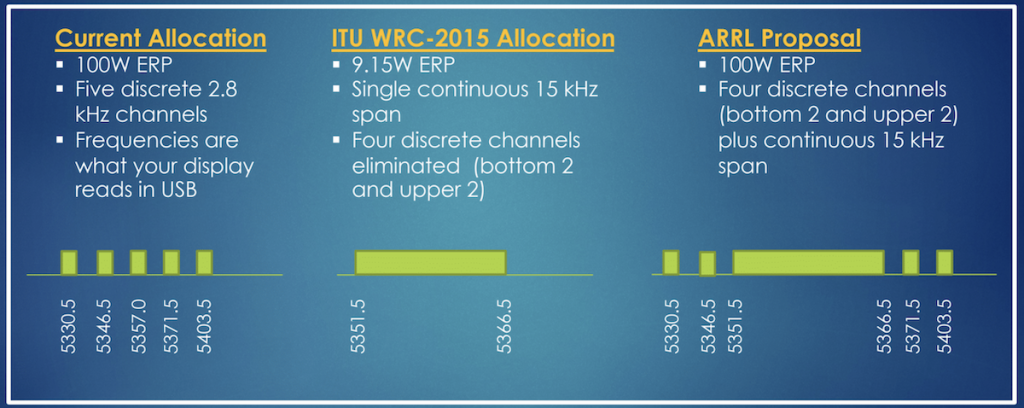
ARRL Urges Comments to FCC on 60-Meter Band
QST de W1AW
ARRL Bulletin 26 ARLB026
From ARRL Headquarters
Newington CT October 11, 2023
To all radio amateurs
SB QST ARL ARLB026
ARLB026 ARRL Urges Comments to FCC on 60-Meter Band
The ARRL is asking that all radio amateurs urge the Federal Communications Commission (FCC) to continue the existing use of the 60-meter band. A public comment period is open until October 30, 2023. ARRL encourages expressions of support to the FCC for the current 100 W ERP power limit (instead of reducing the power limit to 15 W EIRP) and continuing secondary access to the current channels.
To submit a filing of your comments for the FCC’s consideration in the rulemaking process, go to the FCC web page for the Notice of Proposed Rulemaking’s (NPRM) Docket Number 23-120 at, https://www.fcc.gov/ecfs/search/docket-detail/23-120.
If you wish to directly enter your comments, select the button labeled SUBMIT AN EXPRESS FILING at, https://www.fcc.gov/ecfs/filings/express?proceeding5d=23-120 .
If you are uploading a document that contains your comments, select SUBMIT A STANDARD FILING at, https://www.fcc.gov/ecfs/filings/standard?proceeding5d=23-120 .
When submitting your comments, be sure the correct proceeding’s docket number, 23-120, is included on the form. Your name and comments will be entered into the official public record of the proceedings and will be viewable by anyone who visits the docket web page.
While radio amateurs are encouraged to include any comments they would like in their submissions, they’re especially encouraged to draw upon their personal experiences using the 60-meter band for public service purposes and for its location between the amateur 80- and 40-meter bands, which is critical to ensuring signal propagation to certain geographic areas during variations in time and the solar cycle.
Some of the main points to comment on for this NPRM are:
* Urging the FCC to keep the four existing channels allocated to amateur radio on a secondary basis.
* Urging the FCC to keep the 100 W power limit for the four existing channels and the new 15 kHz subband.
ARRL Public Relations and Outreach Manager Sierra Harrop, W5DX, underscored the importance of commenting, urging members to speak up. “ARRL members make up the strongest voice in matters of amateur radio spectrum defense,” said Harrop. “Your membership and participation in the rulemaking process both ensure ARRL continues to make the difference when our band privileges are threatened. Please join us in effort to protect our 60-meter band privileges.”
NNNN
/EX
HF Stock Trading: Blackstone Valley ARC (RI) member quoted in the Wall Street Journal
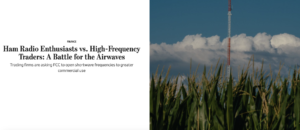 From ri-arrl.org:
From ri-arrl.org:
[Blackstone Valley ARC] member quoted in Wall Street Journal article – “Ham Radio Enthusiasts vs. High-Frequency Traders: A Battle for the Airwaves” (August 5, 2023)
Congrats to (BVARC) Blackstone Valley Amateur Radio Club for this news, shared by Bob Beaudet, W1YRC:
Greetings all:
ARRL Files Comments Against “Seriously Flawed” HF Rules Petition
From ARRL News:
08/02/2023 – ARRL The National Association for Amateur Radio®, as part of its mission to protect Amateur Radio, has filed comments against a proposal that would introduce high-power digital communications to the shortwave spectrum that in many instances is immediately adjacent to the Amateur HF bands.
The “Shortwave Modernization Coalition” (SMC), which represents certain high-frequency stock trading interests, filed the petition with the Federal Communications Commission (FCC). (Previous coverage can be found on ARRL News.) ARRL responded on behalf of its members and the 760,000 licensees of the Amateur Radio Service in the US.
The ARRL Laboratory performed a detailed technical analysis over several months to determine if the proposed rules would affect operations on the bands allocated to Radio Amateurs that are inter-mixed with the Part 90 bands in the spectrum in question.
ARRL’s analysis determined that, if the proposed rules are adopted, the new operations inevitably will cause significant harmful interference to many users of adjacent and nearby spectrum, including Amateur Radio licensees. Ed Hare, W1RFI, a 37-year veteran of the ARRL Lab and internationally recognized expert on radio frequency interference, was the principal investigator on the study. Hare concluded the petition should not be granted. “This petition seeks to put 50 kHz wide, 20,000-watt signals immediately next to seven different amateur bands with weaker protections against interference than required in other services,” said Hare.
In its formal opposition, ARRL stated, “That destructive interference would result if operations commenced using anything close to the proposed maximum levels.”
ARRL’s filed comments highlight flawed analysis and incomplete data submitted by the petitioners. It noted the petitioners “…significantly understate the harmful interference that is not just likely, but certain, if the rules proposed by SMC are adopted as proposed. It is noteworthy that SMC’s proposed rules would provide less protection than the much-lower power amateur radio transmitters are required to provide Part 90 receivers.” ARRL’s opposition also noted that there was no reported tests conducted with Amateur or other affected stations, but referenced a spectrum capture in the Comments filed with the Dayton Group that showed actual interference into the Amateur 20-meter band from one of the High Frequency Trading experimental stations.
Part 90 HF rules currently authorize a maximum signal bandwidth equal to a voice communications channel, at up to 1000 W peak envelope power (PEP). The petition seeks multiplication of signal width, greater transmitted power, and weaker rules that protect users of adjacent spectrum. ARRL’s comments expose the likely fallout:
“Incredibly, notwithstanding the significant increase in potential interference that would result from using digital schemes with 50 kHz bandwidths and 20,000 watts of power, SMC also proposes to substantially lessen the protections required to protect adjacent and neighboring licensees. SMC proposes [out-of-band emissions] limits that offer less protection than the existing Part 90 limits and would actually permit no attenuation (0 dB) at the edge of adjacent allocations, many of which are bands allocated to and heavily used in the Amateur Radio Service. Consistent with lessening protections while increasing the potential for harmful interference, SMC also proposes a lower limit for spurious emissions. SMC would reduce the existing protection of -73 dB for the applicable 1000-watt power limit to just -50 dB protection for their proposed 20,000-watt limit. Due to the much wider 50 kHz proposed bandwidth, the resulting interference would penetrate deep into the adjacent Amateur bands.”
The proposal has been assigned FCC Docket No. RM-11953. While the period for commenting on the petition has now closed, replies to comments in the record may now be submitted.
Hundreds of licensed Radio Amateurs filed comments in the Docket, expressing overwhelming opposition to the proposal. Those interested may read ARRL’s full comments and the results of the technical analysis, which are included in the filing. “If granted as written, this would be devastating to Amateur operation for many tens of kHz into our bands,” said Hare.
ARRL will continue to advocate for its members and the Amateur Radio Service in this proceeding.
